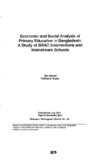Economic and social analysis of primary education in Bangladesh: a study of BRAC interventions and mainstream schools
Citation
Ahmad, A., & Haque, lftekharul. (2011, November). Economic and social analysis of primary education in Bangladesh: a study of BRAC interventions and mainstream schools. Research Reports (2010): Economic Studies, Vol - XXVII, 60–133.Abstract
Bangladesh has achieved significant progress in enrolment in primary schools
including gender parity. Currently, two major problems are dropout before
completing primary education and poor quality of education with low attainment of
basic competencies. These problems are especially acute among children of poor
families. While the government of Bangladesh has the major responsibility of primary
education, and it aims at universal access to education through government schools,
the needs of the very poor are largely catered by non-formal and religious schools.
BRAG has, in the past two decades, made significant progress In providing primary
education to poor children through targeted interventions. The type of education
provided by diverse actors is likely to have different impact on individuals and society.
There are, however, very few studies on economic and social analysis of primary
education in Bangladesh, especially with respect to education provided by different
types of schools. There is also a lack of cost-benefit analysis of primary education,
and cost -effectiveness study of specific interventions. This study focuses on the
diverse outcomes of primary education, and private and social costs of providing
primary education by BRAG and mainstream providers in rural Bangladesh. The
study is based on school and household level primary data collected during
December 2009 to February 2010. Specifically, it addresses the following aspects:
1. Performance of schools in terms of dropout, repetition and completion rates of
children (internal efficiency)
2. Factors associated with internal efficiency
3. Effects of BRAG pre-primary education on the performance of poor children in
formal schools
4. The role of BRAG non-formal schools in enhancing completion of primary level
education among poor children in rural areas
5. School participation pattern and educational achievement of children in rural
Bangladesh from household-level data
6. Effects of education on occupational pattern and income
7. Assessing private and social benefits and costs of primary education
8. Estimating private and social rates of returns to education and comparing the
cost-effectiveness of different interventions
Household level longitudinal data, school level data and data on socioeconomic
background of selected poor students are used in the study.
Main findings
Following are the major findings of this study:
• Household level data indicate that there has been substantial improvement in the
enrolment of children at primary level (95.2% among age group 7-11) in 2010
since mid-1980s. Since many children do not start school at the official age of 6
years, the overall rate of enrolment of children aged 6-10 years is lower (92%).
The enrolment rate at secondary level has also improved over time but it is still
low especially among the very poor (52%).
• Low enrolment rate among children aged 6 indicates late start at school.
Children from poor families especially male children tend to start late. This has
negative implications for completion of primary education and quality of learning.
• Our study confirms that early childhood development through pre-primary
education has significant impact on school performance. The scores achieved in
primary school examination are higher for students with pre-primary (BRAG)
education compared to students without such education. This effect is especially
prominent among girls from poor families.
• Private economic benefits of education are higher for secondary education than
primary education within all occupations. However, private rate of returns are
higher for primary education than secondary because of low private cost at
primary level and high cost at secondary level.
• High social costs of primary education are compensated by many social benefits
reflected in low fertility, improved health practices, greater technology exposure
and positive attitude to children's education especially for girls. Primary
education of mothers is one of the significant factors determining the probability
of children going to secondary school.
• There are differences in cost effectiveness of different interventions. Internal
efficiency indicators are better for BRAG schools than mainstream schools. Cost
per student completed is lower, and private rate of return is higher for BRAG.
Greater efficiency is achieved through intensive monitoring and teacher input in
spite of modest physical facilities.
• Policy and research implications of our study are: intensive effort needed to bring
children from ultra poor families into the formal system of education; free and
compulsory pre-primary education can alleviate the problem of late start at
school as well as improve the quality of primary education; general financial
support to students at the secondary level needed; and there is urgent need for
research on cohort analysis of dropout and completion rates through matching
of household and school level data.

